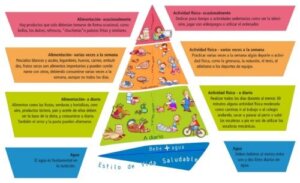NAOS Pyramid: Strategies to Prevent Juvenile Obesity


Written and verified by the nutritionist Saúl Sánchez Arias
Youth obesity is a global health problem that must be solved. To this end, strategies have been created, such as the NAOS pyramid, which is part of a comprehensive plan aimed at improving the functioning of young people’s bodies.
It’s intended to place special emphasis on the need for proper nutrition.
The first thing to keep in mind is that the NAOS pyramid brings a series of general recommendations regarding nutrition. This isn’t always the most appropriate. In many cases it will be necessary to individualize and adapt according to particular requirements. For example, adolescents who practice regular physical activity may need a higher protein intake.
Key points of the NAOS pyramid
Good lifestyle habits are at the base of the NAOS pyramid. You need to remain physically active in order to ensure that your body is functioning efficiently.
This will also allow more energy to be expended at the end of each day, which will help to avoid the accumulation of adipose tissue. Sleeping 8 hours a day will be key to make a difference in terms of health.
Within the specific sections of nutrition, the NAOS pyramid banks on the regular consumption of plant-based foods. These products have proven to be very positive for health due to their content in antioxidants and essential micronutrients, such as vitamins. These are elements that can help prevent the development of chronic and complex pathologies.
In general terms, the NAOS plan always prioritizes the presence of fresh foods. Industrial ultra-processed foods contain simple sugars, trans fats and additives. These elements increase the levels of internal inflammation, which causes many organs to suffer. According to a study published in BMJ, they could increase the risk of suffering diabetes over the years.
On the other hand, it’s also committed to consume complex carbohydrates. The consumption of foods such as pasta, rice, tubers and legumes is prioritized. Also cereals.
On this point there is some controversy in the scientific community. Not all people need complex sugars in large quantities. Those who exercise frequently do, but in the cases of the most sedentary young people, it would be good to reduce the intake.

Read more here: 8 Diseases Related to Childhood Obesity
Disadvantages of the NAOS pyramid
Unfortunately, all that glitters isn’t gold. The NAOS pyramid also has some recommendations that are not supported by the latest scientific evidence.
For example, little importance is given to the presence of high biological value proteins in the guidelines. These come from foods of animal origin. They have all the essential amino acids and a good digestibility score.
Proteins are essential macronutrients for muscles to remain active over the years. Getting adequate intake will help prevent future problems, such as sarcopenia. This is evidenced by research published in the journal BioMed Research International.
Nor does the NAOS pyramid give much importance to fermented dairy products. These are related to a better state of health due to their concentration of probiotics.
These bacteria can selectively colonize the digestive tract, reducing the incidence of many inflammatory pathologies. They will be determinant in order to prevent constipation, and diarrhea, and to improve the absorption of certain nutrients.
In any case, restricting ultra-processed foods in the diet will help to avoid negative alterations in the intestinal microbiota. Trans fats and additives could reduce the density and diversity of microorganisms that inhabit the digestive system.

Read more here: Fun Exercises to Fight Childhood Obesity
The combination of strategies is the best option
The NAOS pyramid is focused on offering a series of general health recommendations with the aim of preventing youth obesity. However, this doesn’t mean that it’s suitable for everyone, as, in many cases, it’s advisable to individualize. If in doubt, it’s best to consult a nutrition professional for a tailor-made plan.
Finally, special emphasis should be placed on the need to promote good habits as a whole. It isn’t enough just to focus on diet. It’ll be essential to practice physical activity on a regular basis in order to consolidate an optimal state of health.
All cited sources were thoroughly reviewed by our team to ensure their quality, reliability, currency, and validity. The bibliography of this article was considered reliable and of academic or scientific accuracy.
- Aune, D., Giovannucci, E., Boffetta, P., Fadnes, L. T., Keum, N., Norat, T., Greenwood, D. C., Riboli, E., Vatten, L. J., & Tonstad, S. (2017). Fruit and vegetable intake and the risk of cardiovascular disease, total cancer and all-cause mortality-a systematic review and dose-response meta-analysis of prospective studies. International journal of epidemiology, 46(3), 1029–1056. https://doi.org/10.1093/ije/dyw319
- de Souza, R. J., Mente, A., Maroleanu, A., Cozma, A. I., Ha, V., Kishibe, T., Uleryk, E., Budylowski, P., Schünemann, H., Beyene, J., & Anand, S. S. (2015). Intake of saturated and trans unsaturated fatty acids and risk of all cause mortality, cardiovascular disease, and type 2 diabetes: systematic review and meta-analysis of observational studies. BMJ (Clinical research ed.), 351, h3978. https://doi.org/10.1136/bmj.h3978
- Martone, A. M., Marzetti, E., Calvani, R., Picca, A., Tosato, M., Santoro, L., Di Giorgio, A., Nesci, A., Sisto, A., Santoliquido, A., & Landi, F. (2017). Exercise and Protein Intake: A Synergistic Approach against Sarcopenia. BioMed research international, 2017, 2672435. https://doi.org/10.1155/2017/2672435
This text is provided for informational purposes only and does not replace consultation with a professional. If in doubt, consult your specialist.








